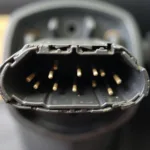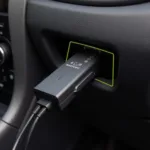Are you trying to connect your OBD2 scanner to your vehicle with a Deutsch 9 pin connector and feeling lost? Don’t worry, you’re not alone. This guide will cover everything you need to know about Deutsch 9 pin to OBD2 connections, helping you diagnose and troubleshoot your vehicle with ease.
While most modern vehicles have standardized OBD2 16-pin ports, some manufacturers, particularly in the heavy-duty truck and industrial machinery sectors, utilize the Deutsch 9 pin connector for diagnostics. This can pose a challenge for vehicle owners who want to use standard OBD2 scanners for tasks like reading and clearing error codes, monitoring engine performance, and analyzing sensor data.
Understanding the Deutsch 9 Pin Connector
The Deutsch 9 pin connector is a circular, environmentally sealed connector often found in heavy-duty vehicles and off-road equipment. Its robust design makes it suitable for harsh conditions where vibration, moisture, and dirt are common. While it serves a similar purpose to the OBD2 port, its different configuration requires a dedicated adapter for compatibility with standard OBD2 scanners.
Why You Need a Deutsch 9 Pin to OBD2 Adapter
A Deutsch 9 pin to OBD2 adapter acts as a bridge between your vehicle’s diagnostic port and your OBD2 scanner. It allows you to connect your OBD2 scanner to the Deutsch 9 pin port and access your vehicle’s diagnostic data seamlessly. This is essential for:
- Retrieving and clearing diagnostic trouble codes (DTCs): Identify and address issues triggering warning lights on your dashboard.
- Monitoring live data: Analyze real-time engine performance data such as speed, RPM, coolant temperature, and more.
- Conducting component tests: Activate specific vehicle components, like solenoids or relays, to check their functionality.
Choosing the Right Adapter
Selecting the correct Deutsch 9 pin to OBD2 adapter for your needs is crucial for compatibility and accurate data transmission. Keep these factors in mind:
- Vehicle Compatibility: Ensure the adapter supports your specific vehicle make and model.
- OBD2 Protocol Support: Verify the adapter is compatible with the OBD2 protocols used by your vehicle.
- Adapter Quality: Opt for a well-built adapter with durable construction and high-quality wiring to ensure reliable connections.
J1939 to OBD2 adapter schematic
“When choosing an adapter, pay close attention to the pin configuration,” advises John Miller, a seasoned automotive engineer. “A mismatched adapter can lead to inaccurate readings or even damage to your vehicle’s electrical system.”
Common Applications of Deutsch 9 Pin to OBD2 Adapters
Deutsch 9 pin to OBD2 adapters have a wide range of applications, particularly in the following sectors:
- Heavy-duty trucking: Diagnosing and troubleshooting issues in semi-trucks, buses, and other large commercial vehicles.
- Agriculture: Analyzing and managing engine performance in tractors, combines, and other farming equipment.
- Construction: Monitoring and maintaining the health of construction machinery, including excavators, bulldozers, and cranes.
- Marine: Diagnosing engine problems and monitoring system performance in boats and other watercraft.
Troubleshooting Tips
While Deutsch 9 pin to OBD2 adapters are generally straightforward to use, you might encounter some common issues. Here are some troubleshooting tips:
- Connection Issues: Ensure the adapter is securely connected to both the vehicle’s Deutsch 9 pin port and the OBD2 scanner.
- Power Problems: Verify that your vehicle’s ignition is switched ON to provide power to the diagnostic port.
- Compatibility Errors: Double-check that the adapter is compatible with your specific vehicle make, model, and OBD2 protocols.
Conclusion
Navigating the world of Deutsch 9 pin connectors and OBD2 diagnostics can seem daunting, but armed with the right knowledge and tools, it becomes a manageable task. A Deutsch 9 pin to OBD2 adapter is an essential tool for anyone who owns or works with heavy-duty vehicles and equipment fitted with this type of diagnostic port. By understanding its importance, choosing the right adapter, and following best practices, you can ensure accurate diagnoses, effective troubleshooting, and optimal performance for your vehicle.

